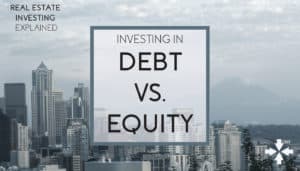FREE TRAINING
What is Real Estate Crowdfunding?
Learn how to build wealth and earn passive income in real estate while someone else does all the work.
Benefits of Using Self-Directed IRAs For Real Estate

Alternative Assets
Recent research indicates that including alternative investments in a portfolio increases risk-adjusted returns. These “out of the norm” investments range from real estate to market funds, such as lending platforms or other less tread investment paths. Institutional investors have embraced alternative assets to the tune of billions of dollars and are in the process of moving more and more of their investment dollars into these assets.
In 2009, the market for alternative investments sat at $3 trillion. That number is predicted to hit $14 trillion by 2020. Despite all we hear about the phenomenal growth in the traditional equity markets, alternative investments are also performing well.
Alternatives to stocks, bonds, and mutual funds are quickly becoming necessary to maintain a truly diversified portfolio.
Traditional IRAs limit your choices when it comes to retirement assets. Most of the time, a retirement account will be managed by a company or plan provider, who chooses what stocks, bonds, and mutual funds to add to ones portfolio. Some standard IRAs offer account holders limited management capabilities, but the account holder is still restricted from investing in alternative assets like real estate, tax lien certificates, precious metals, etc.
If you have clients that are interested in adding these assets to their tax-deferred retirement portfolios, there is a solution- a Self-Directed IRA.

Demand for Alternative Investments is Skyrocketing
According to Institutional Investor, demand for alternative investments is on the rise. Large investors like foundations, endowments, and pensions are making moves to dramatically increase their private investment holdings. Alternative assets like real estate, private debt, private equity, and others will likely benefit from increased allocations.
The impetus for the move to alternative asset classes is largely driven by the desire to hedge against risk. Many of these institutional investors see an unprecedented bull run and can’t help but wonder- when does the music stop? When it comes down to it, institutional investors and RIAs have the same goal- to grow their client’s money when possible, and to protect it at all times.
The diversification and tax-deferral benefits offered by Self-Directed IRAs allow you to accomplish both tasks at the same time.
Use a Self-Directed IRA to Take Advantage of Alternative Investments
Using a Self-Directed IRA opens up a world of investment possibilities for your clients. You can deploy capital in a wide variety of assets, like real estate, tech startups, extending credit/loans, promissory notes, private placements, and many others.
Diversification Benefits
The primary benefit of using a Self-Directed IRA is diversification. Instead of being tied up in traditional stocks, bonds, ETFs, and mutual funds, your client can gain exposure to other sectors that most retirement accounts have no presence in or a limited presence.
Deploying capital in assets that are not tied to the stock market is an excellent hedge against the volatility inherent in the equities markets. Alternative investments will have a stabilization effect on their portfolio because they are not tied to the market.
More Control
Another benefit offered by the use of a Self-Directed IRA is a higher degree of control over your client’s financial future. They’re the ones educating themselves on investments, making the decisions, and are ultimately responsible. If they see a dynamite real estate opportunity or sense a shift in the commodity markets- they can invest accordingly.
Asset Protection
One of the primary reasons to leverage a Self-Directed IRA is to better protect your clients’ assets. For example, someone who purchases a multi-family property with a Self-Directed IRA can have multiple exit strategies, from sale or refinance, to value-add improvements / repositioning and more. This provides more options for protecting the investment in the event of a downturn, the same for which cannot be said about investments in stocks, bonds and the like. Moreover, even in a downturn where real estate values decline, investors will still often benefit from continual cash flow.
Intergenerational Planning
Real estate has historically been a multi-generational builder of wealth, and that continues to be true when people invest in real estate through their Self-Directed IRA. Unlike traditional IRAs, in which the beneficiaries have to distribute the value of the entire IRA over ten years, a Self-Directed IRA can utilize what’s known as “stretch” provisions to pass the tax free Roth IRA growth on to heirs over their [the beneficiary’s] entire lifetime. This provides tremendous value for those engaged in inter-generational planning.
Get access to our FREE weekly newsletter exclusively covering the latest updates from the real estate crowdfunding world
How to Switch Over to a Self-Directed IRA
Many retirement savers are in the dark about if and how they can switch to a Self-Directed IRA. First of all, they are not limited to traditional IRAs- they can switch over with Roth IRAS, SEP or Simplified Employee Pension IRAs, or a Simple IRA. They can roll over a 401k from their current or previous employer- this is a fantastic opportunity for you to assist them in maximizing the value of their 401k.
Here is an in-depth rundown on how to switch to a SDIRA
The client starts by moving their account from their current provider. If they do not have an IRA account, they would start one with a custodian. The account would be for a single individual, and it would be in their name. You can then assist them in deciding what kind of IRA works best for their investment goals, like a Roth or SEP. Once they have a place to put their IRA, they would begin a request with their current custodian or 401k manager for a rollover to be put into the new IRA.
Once their new account is set up, it's time to create an investment strategy.
This is the point where they determine precisely which assets they will purchase, and how much capital they will deploy for each investment. Let's say they want to invest in a real estate fund. They would fill out an investment authorization telling the custodian to move the money as they see fit.
In a Self-Directed IRA, the custodian is a "passive custodian," which means their job is exclusively to fulfill investment requests. They do not provide fiduciary assistance, and they cannot deny account holders from choosing a suitable place to park their money, which is usually in a private placement, like a PPM, or an LLC. They will request to see documents related to the investment to ensure that it meets the terms outlined in the IRS regulations governing Self-Directed IRAs.

Self-Directed IRA Fees
With a Self-Directed IRA, there are two common fee structures. The first is asset based- that is similar to the percentage-style fees they pay with most investment accounts. The other is a flat rate, where they pay a set amount per transaction. These fees are either paid in full annually or are split up quarterly- how they are structured depends on the custodian they choose. Which fee structure is better depends on the situation, but the majority of the time a flat rate is the way to go.
Asset-Based
When your client opts to purchase real estate with a Self-Directed IRA, the title of the property must be held in the name of the IRA. The custodian of the account must handle all transactions, such as hiring a property manager and/or landscaping company. In the asset-based approach to fees, the custodian will charge a fee for every transaction they manage related to the asset on behalf of the owner. This can also include a percent fee on rents collected for the asset. These transaction fees can add up over time.
Looking to expand your knowledge about Real Estate check out our Free Hidden Secrets to Success in Real Estate training course.
Flat Rate
An alternative fee structure is the flat rate fee, often referred to as “checkbook control” because the investors retain control of their checkbooks. This fee structure can save investors significant money, but it comes with some additional legwork. It requires the owner of a Self-Directed IRA to set up a limited liability company (LLC) that is owned entirely by the IRA. The owner then directs his Self-Directed IRA custodian to invest the IRA in the LLC, which the owner then manages him/herself.
This allows the owner to manage all costs associated with the real estate investment themselves. The checkbook model usually has higher setup fees than the asset-based fee structure, but the owner will only pay a marginal flat-rate fee to the custodian on an annual basis thereafter. Flat rate fees tend to be more predictable for those looking to manage costs carefully.
SDIRA Asset Allocation
The amount of capital they deposit into their new account is entirely up to them. Their custodian cannot and will not give them advice regarding asset allocation. Some retirement savers choose to put their entire nest egg into a Self-Directed IRA, while others only put a small percentage- at the end of the day, it is their decision.
Industry-wide, the average number ranges between 20 and 30 percent of an investor's net worth.
Somewhere between 20 and 30 percent is often said to be the ideal amount to change risk-adjusted returns for the better, primarily for diversification purposes.
Real Estate Tax Benefits Offered by Self-Directed IRAs
Tax Deferred
A tax benefit that begins immediately upon deposit is the tax-deferred status on the account. This means they do not have to pay any taxes on the profits they make until they withdraw their capital upon retirement. They may be wondering if there is a way they can take advantage of real estate depreciation through their new account.
If they are a passive investor, they will not have the opportunity to write off depreciation for costs with those projects. There are some niche situations where they may be able to receive depreciation benefits, but these are few and far between.
Deductible Contributions
For those who earn under a certain income threshold, contributions to Self-Directed IRAs can be fully tax deductible. This means that someone can take an effective tax deduction of up to $5,550 per year, or up to $6,500 per year for those over age 50, thanks to the catch-up contribution provision. This tax deduction is not available to those who invest in Roth IRAs. Moreover, those who earn more than the income threshold (which changes each year) can still benefit from other tax advantages, such as the tax deferral discussed above.
Self-Directed Retirement Accounts
Self-Directed IRAs are a great tool for those looking to invest in an array of alternative investments, from real estate to precious metals, private equity and more. There are tax advantages associated with each of these alternative investments, the most lucrative being tied to real estate investments. Those who invest through a traditional or Roth IRA are otherwise limited to stocks, bonds and other traditional investments. Self-Directed retirement accounts allow investors to diversify their holdings, which provides more stability over the long-term.

Using a SDIRA To Invest in Development Projects
They can use an SDIRA to invest in real estate development funds, crowdfunding efforts, commercial buildings, and a whole host of other real estate projects. To get started, they need to find a developer who is willing and able to receive funds from a SDIRA.
This should not be hard, as most seasoned developers are familiar with the process and have systems in place to ensure the transaction goes smoothly. They simply choose the percentage of funds from their SDIRA that they want to deploy for each project, set up instructions for the bank wire, and they’re in business.
Real Estate Development Funds
Not all investors want to own real estate directly, via a custodian, LLC or otherwise. An alternative approach is for your client to use their Self-Directed IRA to invest in a real estate development fund, often referred to as a syndication. Real estate development funds pool capital (debt and/or equity) to invest in projects that are then managed by the sponsor. This allows individual investors to take on a more passive role while still owning a piece of a real estate development project.
Crowdfunding Efforts
Several real estate crowdfunding platforms have emerged in recent years, allowing people to invest in real estate with as little as $100. Fundrise, RealtyMogul and CrowdStreet are just a few of the websites that source capital for real estate deals. Several of these platforms also allow people to invest with a Self-Directed IRA. Crowdfunding efforts can be an especially good option for those looking to passively invest with a sponsor taking on the rest of the deal’s legwork.
Related: Guide to Real Estate Crowdfunding and Best Platforms
Commercial Buildings
Few clients will have the cash on hand needed to buy a commercial building. Instead, encourage them to consider the benefits to using a Self-Directed IRA to invest in commercial property. Those who’ve rolled over money from a Traditional or Roth IRA will be more likely to have the funds needed to buy commercial buildings than those looking to use their savings accounts alone. Real estate development funds and crowdfunding efforts are two ways by which an investor can buy property through their Self-Directed IRA.
For more information and to gain access to:
- Guided tour of 8 real estate crowdfunding websites
- FREE: Complete list of every real estate syndication website
- FREE: 10 things to look for in real estate contracts
- Access to advanced real estate investment training
Self-Directed IRAs and Recessionary Periods
Any investor worth their salt knows, it isn't if the next correction will occur, it is when. Concerns about liquidity, appreciation, and cash flow from RE assets all come to mind when discussing a potential dip in the real estate markets- most of us still remember the 2008 crash like it was yesterday.
There are a few ways that you can help protect their real estate assets from downturns. Before deciding to invest in a given market, make sure that it is showing stabilized signs of growth- you want there to be high absorption rates to ensure appreciation and a regular tenant supply.
Look for indicators that show the supply of available properties in a given region will shrink rapidly. Typically, a region with an absorption rate above 20 percent signals that there is a seller's market, where properties will be scooped up quickly. Holding property in an area with a high absorption rate can also help add some liquidity to their portfolio, as they can generally expect to sell a property quickly since it is a seller's market.
Take into account how much of an appreciation loss they can take before holding the property becomes financially unviable. During a recession, property values may drop 10, 20, or even 50 percent- try to invest in areas where even a precipitous drop will not wipe out the value of their assets.
The developer they choose should be running stress tests to determine if they can remain profitable. For example, instead of running at 100 percent occupancy, what happens at 90 percent, 80 percent, etc. By running these tests, they are trying to determine their break-even point, which at least returns investors initial capital outlay.
Legal Issues Surrounding Self-Directed IRAs
As long as your clients work within IRS guidelines, using a Self-Directed IRA is entirely legal. There are rules and regulations that they need to follow when they get involved with a Self-Directed IRA, primarily relating to taxes. They can't invest in life insurance, or collectibles, or engage in any other IRS-prohibited transaction.
***
Self-Directed IRAs offer registered investment advisors a way to diversify their client’s portfolios with assets other than traditional stocks, bonds, and mutual funds.
The real estate market is of particular interest to many retirement savers, and many are keen to invest part of their nest egg in a tax-deferred real estate asset.
Consider adding a Self-Directed IRA asset to your wheelhouse to better meet your clients’ desire for alternative retirement investments.
Newbie
If you want to build your wealth and earn passive income from real estate investing and are looking at deals on marketplace platforms or through developers online, then I recommend you start by the 8 Key Financial terms so you can understand every deal you look at.
The 8 Financial Keys are not only a great way to get started, they are also essential to understanding how you’ll make money in any real estate deal.
You’ll learn the most important financial concepts you need to know in real estate investing that apply to every type of real estate no matter the asset class (office, industrial, residential, hospitality, retail).
Intermediate Investor
If you’ve got some online real estate investments under your belt already and are beginning to receive passive income checks each month, or have been paid off with profit – or (hopefully not) are finding that some deals are not quite panning out the way you expected, then check out this page for a wealth of free resources.
Here I cover everything from beginner all the way to very advanced real estate concepts.
You’ll find podcasts with developers, researchers, professors and other industry experts, detailed articles, and lots of videos, both short and long that are all easily searchable and totally free.
Advanced Investors
I am not shy about being straightforward about real estate investing; it is exciting, lucrative, and can help you build wealth and income as part of your investment portfolio, but it is not without its risks.
As an advanced investor you know this already, so I’ve put together a webinar for you that guides you through one of the most important components of real estate investing: Real Estate Contracts – reading between the lines.
This is advanced learning and based off conversations I had with three of the top real estate attorneys in the country, combined with my own personal experience. Access it here; it could be the most important webcast you watch all year.





